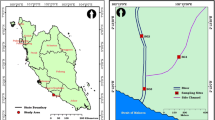Abstract
The transboundary River Nestos in the Balkan Peninsula is a surface water resource shared by Hellas and Bulgaria. The Public Power Corporation of Hellas (DEH) proceeded to the dams' construction of Thesaurus in 1997 and Platanovrissi in 2000, to satisfy the increased needs for power production and irrigation in the Regions of Eastern Macedonia and Thrace in the Hellenic Territory. DEH following the Ministerial Agreement of the Hellenic Parliament ‘`KYA 18492/19—09—1996’' funded a series of Research Projects concerned on the monitoring of the water quantity and quality data of Nestos from the Hellenic-Bulgarian borders to its estuaries in the Thracian sea. ‘`PERSEAS’' Research Group from Aristotle University of Thessaloniki, carried out the research, design, construction, installation, operation and maintenance of the ‘`R.E.MO.S.’' (Remote Environmental MOnitoring System) networks. Three REMOS networks have been installed in the areas of (a) the River Nestos deltaic channel, (b) Thesaurus dam-lake in the intramountainous valley and (c) Potamoi (Despat) and Pagoneri (Nestos) villages close to the borders between Hellas and Bulgaria. They record water level (H), water and air temperature (T), water conductivity (ECw), Redox potential (RP) and dissolved oxygen (DO) on a 24h basis, since the beginning of the year 2000. The research carried out in this paper, is focused on the REMOS station in the final course of Nestos in the deltaic area. The continuous monitoring and the data analysis yield useful results for the quality and quantity of the hydrologic regime of Nestos after the dams' construction, as well as for the trends detected of the quality parameters (ECw, RP and DO) and the water level, using the nonparametric Spearman's criterion. The best fitted model of time trend, for each variable, was chosen. The statistical sample of each one of the quality variables consisted of about 1000 values based on daily measures on a three years monitoring program (1/1/2000—31/12/2002). Further research and analysis for the other network stations of REMOS should provide useful results for the sustainable management of the transboundary River Nestos.
Similar content being viewed by others
References
Albanakis, K., Mitrakas, M., Moustaka-Gouni, M. and Psilovikos, A.: 2001, ‘Determination of the environmental parameters that influence sulphide formation in the newly formed Thesaurus reservoir, in Nestos river, Greece’, Fresen. Environ. Bull. 10(6), 566–571.
Antonopoulos, V. and Papamichail, D.: 2002, ‘Trend analysis of water quality parameters for two transboundary rivers in Northern Greece’, in: Proceedings of International Conference ‘Protection and Restoration of the Environment VI’, July 1–5, 2002, Skiathos, Hellas, Vol. 1, pp. 83–90.
Antonopoulos, V., Papamichail, D. and Mitsiou, K.: 2001, ‘Statistical and trend analysis of water quality and quantity data for the Strymon River in Greece’, Hydrol. Earth Syst. Sci. 5(4), 679–691.
Choleev, I. and Baltakov, G.: 1989, ‘Basic features of the late Cenozoic evolution of the Mesta valley system on Bulgarian territory’, in: Proceedings of International Conference ‘Geographica Rhodopica’, 1989, Sofia, Bulgaria, Vol. 1, pp. 14–17.
Gerakis, A. and Kalburtzi, K.: 1998, ‘Agricultural activities affecting the functions and values of Ramsar wetland sites of Greece’, Agr. Ecosyst. Environ. 70(2–3), 119–128.
Hirch, R., Alexander, R. and Smith, R.: 1991, ‘Selection of methods for the detection and estimation of trends in water quality’, Water Resour. Res. 27(5), 803–813.
Moustaka-Gouni, M., Albanakis, K., Mitrakas, M. and Psilovikos, A.: 2000, ‘Planktic autotrophs and environmental conditions in the newly-formed hydroelectric Thesaurus reservoir, Greece’, Arch. Hydrobiol. 149(3), 507–526.
Paraskevopoulos, A., Georgiadis, Tsaktsiras, K. and Pangaia, C.: 1994, ‘Study of the environmental effects on the broader area of the Hellenic basin of the river Nestos’, Technical Report, Public Power Corporation of Greece (DEH), Vol. A & B.
Psilovikos, A.: 1992, ‘The case of river deltas on the costs on the Aegean and the Ionian seas’, in: P.A. Gerakis (ed), Conservation and Management of Greek Wetlands, IUCN, Gland, Switzerland, pp. 197–208.
Psilovikos, A. and Collaborators: 1999, ‘Monitoring research of the natural processes of the fluvial system of Nestos River by the construction and operation of a pilot automated telemetric network. Research of the dynamic balance of the suspended soils’, Technical Report —Research Program, Department of Physical and Environmental Geography, Aristotle Univ. of Thessaloniki, Vol. 1–4.
Psilovikos, A. and Collaborators: 2003. ‘Maintenance and documentation of the R.E.MO.S. network of river Nestos’, Technical Report —Research Program, Department of Physical and Environmental Geography, Aristotle Univ. of Thessaloniki, Vol. 1–10.
Psilovikos, A., Vavliakis, E. and Langalis, T.: 1988, ‘Natural and anthropogenic processes of the recent evolution of Nestos delta’, Bull. Geol. Soc. Greece XX, 313–324.
Psilovikos, A., Albanakis, K., Margoni, S., Psilovikos, Ar., Ioannidis, D. and Makrygiorgos, Ch.: 2002, ‘Contribution in the management and environment monitoring of Nestos River’, in: Proceedings of the 6th Pan-Hellenic Geographical Conference, October 7–10, 2002, Thessaloniki, Greece, Vol. 2, pp. 505–512.
Psilovikos, A., Laopoulos, T., Albanakis, K., Psilovikos, Ar., Kosmatopoulos, K. and Margoni, S.: 2004, ‘Contribution of the electronic monitoring to the sustainable management of the transboundary River Nestos. First Approach’, in: Electronic Proceedings of 1st Conference of the Environmental Committee of Aristotle University of Thessaloniki ‘The Implementation of the Water Framework Directive 60/2000/EE in Greece and the European Experience’, November 11–13, 2004, Thessaloniki, Hellas.
Psilovikos, A., Margoni, S. and Psilovikos, A.: 2005, ‘Monitoring Water Quality Parameters of the Transboundary River Nestos’, Am. J. Appl. Sci. 2(4), 759–762.
Stoichev, K.: 1989, ‘Fluctuations concerning the annual stream flow in the Rhodope massif’, Geogr. Rhodopica 2, 158–169.
Zalidis, G. and Mantzavelas, A.: 1996, ‘Inventory of Greece wetlands as natural resources’, Wetlands 16(4), 548–556.
Author information
Authors and Affiliations
Corresponding author
Rights and permissions
About this article
Cite this article
Psilovikos, A., Margoni, S. & Psilovikos, A. Simulation and Trend Analysis of the Water Quality Monitoring Daily Data in Nestos River Delta. Contribution to the Sustainable Management and Results for the Years 2000–2002. Environ Monit Assess 116, 543–562 (2006). https://doi.org/10.1007/s10661-006-7671-9
Received:
Accepted:
Issue Date:
DOI: https://doi.org/10.1007/s10661-006-7671-9




